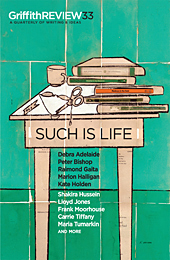Featured in

Buy
$24.95
- Published 20110906
- ISBN: 9781921758225
- Extent: 264 pp
- Paperback (234 x 153mm), eBook

Already a subscriber? Sign in here
If you are an educator or student wishing to access content for study purposes please contact us at griffithreview@griffith.edu.au
Share article
About the author

John Tranter (1943–2023)
John Tranter published more than twenty collections of verse. His collection Urban Myths: 210 Poems: New and Selected (UQP, 2006), won a number of major...
More from this edition

Staffroom confidential
GR OnlineAT THIRTY-TWO I ran away from school. I left in the middle of second term. Severed all ties. Took my books and my Barbie...

The true history of the Circus
MemoirIF I AM to write the true history of the Circus, I must start by telling you how my girlfriend ran off with the...

The blind side
ReportageWHEN GEORGE W Bush began looking for a running mate for his Republican Party ticket before the 2000 election, he chose Dick Cheney to head...
Stay up to date with the latest, news, articles and special offers from Griffith Review.